Creating a bookshelf bed is an ingenious way to maximize space while adding a stylish and functional piece to your bedroom. A bookshelf bed combines the comfort of a bed with the practicality of built-in shelving, making it perfect for small spaces or for those who love to have their favorite reads within arm’s reach. This project involves integrating a bookshelf into the headboard, footboard, or side panels of a bed, providing ample storage for books, decor, and personal items. Not only does this design save space, but it also adds a unique and customized touch to your bedroom decor.
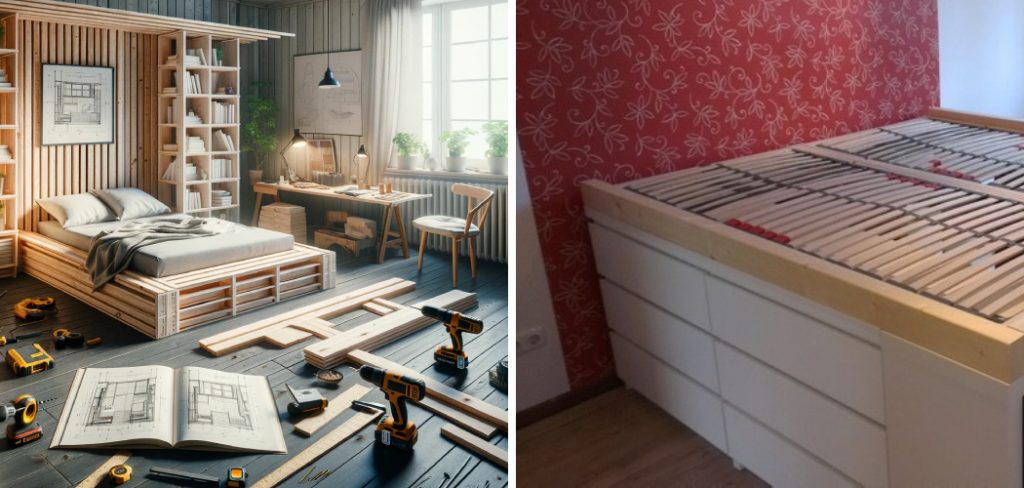
In this comprehensive guide, we will cover everything you need to know on how to make a bookshelf bed, from selecting the right materials and tools to detailed step-by-step instructions on construction and finishing. With a bit of creativity and some basic woodworking skills, you can create a multifunctional piece that enhances both the aesthetic and functionality of your living space.
Dual Functionality and Space-Saving Benefits
One of the major advantages of a bookshelf bed is its dual functionality. By combining a bed and a bookshelf, you can effectively use the same space for both sleeping and storage, making it an ideal solution for smaller bedrooms or studio apartments where maximizing space is crucial. The built-in shelving provides ample room for storing not just books, but also decorative items, personal belongings, or even bedroom essentials like an alarm clock and reading lamp.
This clever integration reduces the need for additional furniture, such as separate bookcases or nightstands, thus freeing up more floor space for other activities. Moreover, having your favorite books and items within arm’s reach can also create a cozy and personalized sleeping area, promoting a serene and organized atmosphere conducive to relaxation and rest.
Versatility and Practicality of Bookshelf Beds
The versatility and practicality of bookshelf beds make them appealing to a wide range of individuals and living situations. For students or young professionals living in small apartments or dorm rooms, the integrated storage ensures that essential items and books are always accessible without sacrificing valuable space. Families can also benefit, especially in children’s rooms where toy storage and bedtime storybooks can be neatly organized within the bedframe.
Additionally, bookshelf beds come in various designs and configurations, allowing for customization to suit specific needs and styles. You can choose from a variety of finishes, materials, and shelving layouts to complement the existing decor of your bedroom. Whether you prefer a minimalist design with clean lines or a more ornate, traditional look, there’s a bookshelf bed to match your aesthetic. This adaptability means a bookshelf bed can evolve with your changing needs and tastes, truly standing the test of time as a functional and stylish furniture piece.
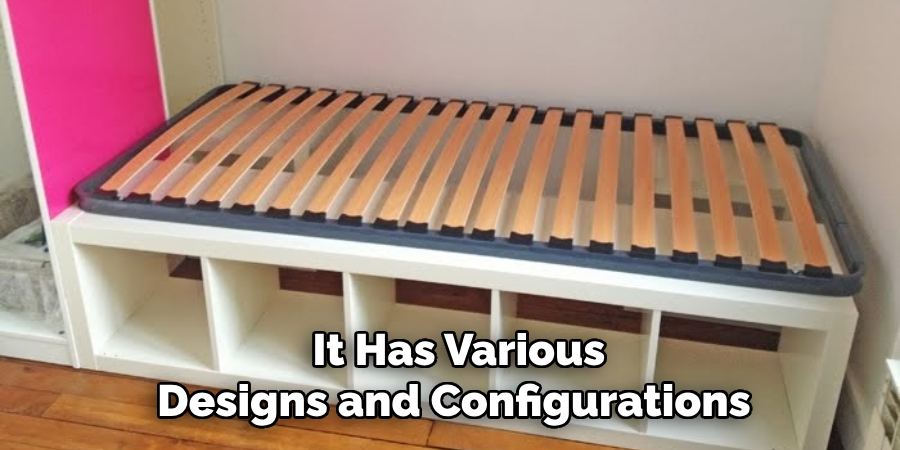
Understanding Bookshelf Bed Design
To successfully design and build a bookshelf bed, it is crucial to understand the key components and considerations involved in the process. The design phase starts with determining the size and placement of the bed, which directly influences the layout and dimensions of the integrated bookshelf. Standard bed sizes—twin, full, queen, or king—can be adapted to include shelving in various configurations. When planning the design, consider factors such as the depth and height of the shelves, ensuring they are accessible and proportional to the bed’s dimensions.
Material selection is another critical aspect of the design. Opt for durable and sturdy materials like solid wood, plywood, or MDF (medium-density fiberboard) for the bed frame and shelves to ensure long-term stability and support. Additionally, incorporating adjustable shelves or removable panels can provide flexibility for different storage needs and preferences.
Pay attention to the overall aesthetics of the bookshelf bed, harmonizing it with the room’s decor. This involves choosing finishes, colors, and hardware that complement your existing furniture and style. Lighting is also an important consideration; incorporating built-in lights or LED strips can enhance the functionality of the bookshelf, making it easier to find items and creating a cozy, ambient atmosphere.
Ergonomics and safety should not be overlooked. Ensure that the bed and shelves are designed and built to withstand daily use, with smooth edges and sturdy joints to minimize the risk of injury. Following detailed design plans and taking accurate measurements will help prevent common pitfalls and ensure a well-balanced, functional, and attractive bookshelf bed.
Basic Components and Features of Bookshelf Beds
Bookshelf beds consist of several key components and features that contribute to their functionality and aesthetic appeal. Understanding these elements is essential for both the design and construction phases.
Headboard with Shelving
One of the most common features of a bookshelf bed is a headboard that includes built-in shelves. These shelves can vary in size and number, offering a convenient place to store books, alarm clocks, reading lamps, and decorative items. The headboard shelves are typically within easy reach when you’re lying in bed, making them ideal for bedtime essentials.
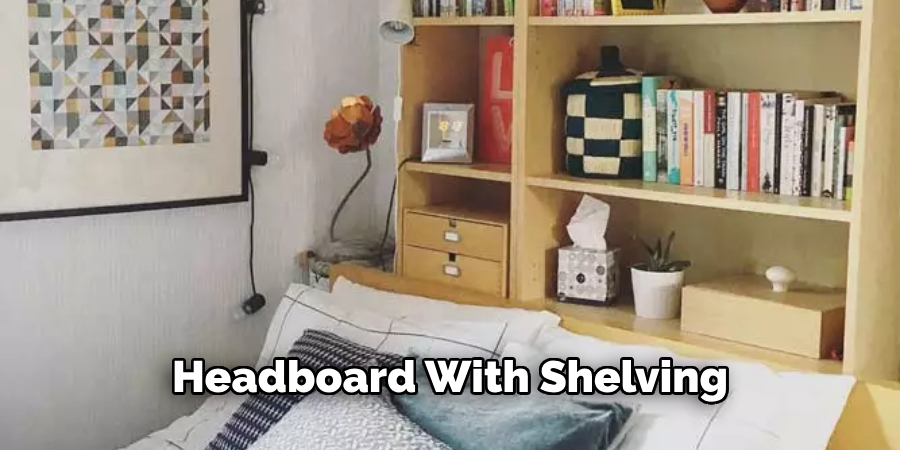
Footboard Storage
Some bookshelf beds also incorporate storage in the footboard. This can take the form of open shelves or closed compartments, depending on your storage needs and design preferences. Footboard storage is perfect for items that you may not need immediate access to, such as extra blankets, shoes, or off-season clothing.
Side Panels with Shelves
Side panels with integrated shelving provide additional storage options and can help keep your bedroom organized. These side shelves are especially useful for small rooms where floor space is limited, offering a place to store books, magazines, or even small bins for personal items. The side panels can be designed with open or closed shelving based on your preference.
Under-Bed Storage
Maximizing the space under the bed is another key feature of many bookshelf beds. Options for under-bed storage include drawers, pull-out bins, or open shelving. This space is ideal for storing bedding, seasonal clothing, or even toys in a child’s room. Under-bed storage helps keep your living space tidy and well-organized without the need for additional furniture.
Adjustable Shelves
Incorporating adjustable shelves within the bookshelf bed can provide flexibility to accommodate different sizes of books and other items. Adjustable shelving allows you to customize the storage space to suit your needs, whether you have large textbooks, small paperback novels, or decorative pieces.
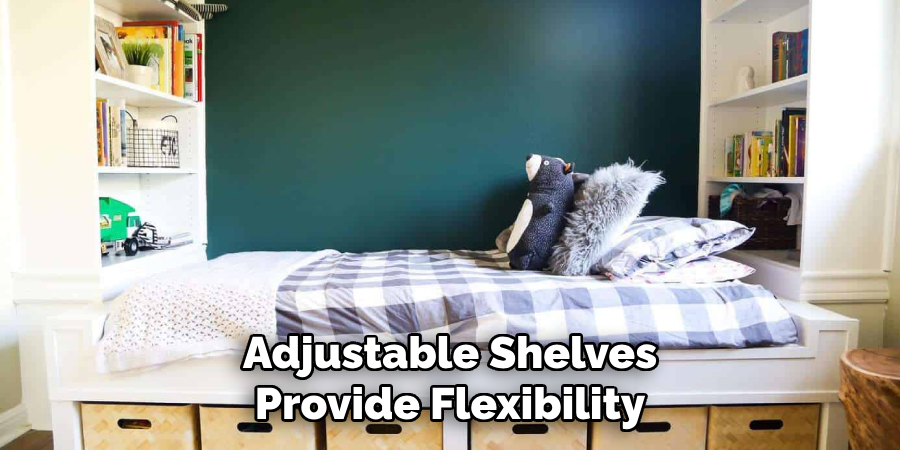
Integrated Lighting
Adding integrated lighting to your bookshelf bed can enhance both its functionality and ambiance. Options include built-in reading lights, LED strips, or even touch-sensitive lamps. Proper lighting makes it easier to find items on the shelves, read at night, and adds a cozy, inviting feel to your bedroom.
Different Types and Styles of Bookshelf Beds
Bookshelf beds come in a variety of types and styles to cater to different needs, preferences, and interior decor themes. Understanding these options can help you choose the ideal bookshelf bed for your space.
Loft Bookshelf Beds
Loft bookshelf beds are designed to maximize floor space, elevating the bed frame to create a versatile area underneath. This design often features integrated shelves and storage in the lofted area, making it perfect for small apartments or children’s rooms. The space beneath can be used for a desk, additional seating, or play area, offering a practical and efficient solution for compact living spaces.
Murphy Bookshelf Beds
Murphy beds, also known as wall beds, are an excellent solution for multifunctional spaces. These beds can be folded up against the wall when not in use, revealing a fully functional bookshelf. The Murphy bookshelf bed combines the convenience of hidden bedding with the practicality of accessible storage. This style is ideal for studio apartments or guest rooms where space-saving solutions are crucial.
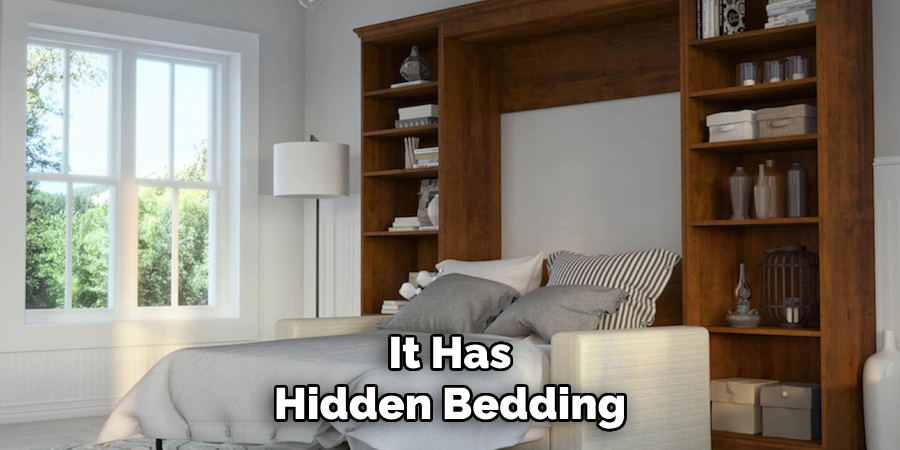
Captain’s Bookshelf Beds
Captain’s beds are characterized by their ample built-in storage options beneath the bed frame. These beds typically feature a series of drawers or compartments, allowing you to keep your belongings organized and out of sight. The headboard often includes additional shelving or cabinets, providing even more storage options. Captain’s bookshelf beds are great for rooms where storage space is at a premium and additional furniture would feel cluttered.
Platform Bookshelf Beds
Platform bookshelf beds have a simple, modern design with a low-profile frame. The bed rests on a flat, solid surface rather than a box spring, often incorporating storage drawers or shelving underneath. The headboard may also feature built-in shelves. This style is suitable for minimalist decor, offering a sleek appearance while also providing functional storage solutions.
Traditional Bookshelf Beds
Traditional bookshelf beds often feature decorative elements such as ornate carvings, moulding, and classic finishes. These beds can blend seamlessly with vintage or classic interior decor, providing functionality without compromising style. The headboard and footboard might include detailed woodwork and integrated shelving that compliments the traditional aesthetic.
10 Methods How to Make a Bookshelf Bed
Method 1: Designing Your Bookshelf Bed
Before you start building, spend time designing your bookshelf bed. Determine the size of the bed frame, the dimensions of the bookshelves, and the overall style you want to achieve. Consider the height of the bookshelves and how many shelves you want. Sketch your design on paper, including measurements and details like the type of wood and finish. This plan will serve as a blueprint, ensuring that you have a clear vision and accurate dimensions for your project.
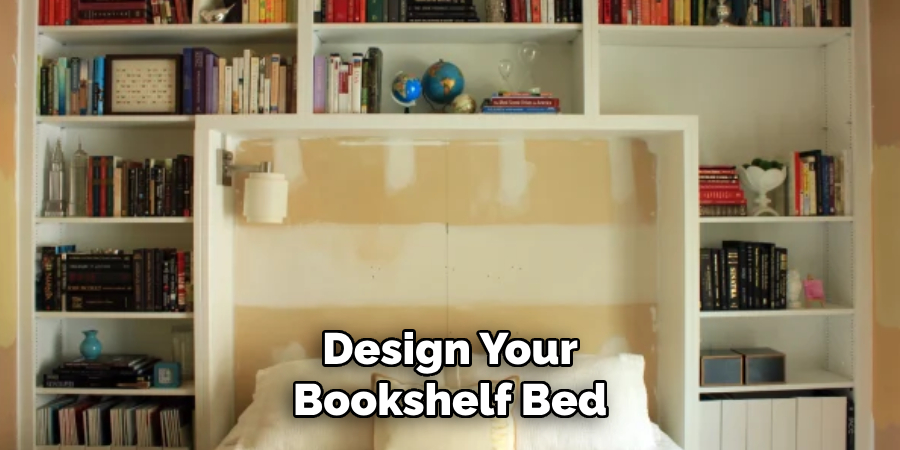
Method 2: Choosing the Right Materials
Selecting the appropriate materials is crucial for the durability and aesthetics of your bookshelf bed. Opt for high-quality plywood or hardwood, as these materials provide strength and a pleasing finish. Plywood is often more affordable and easier to work with, while hardwood offers greater durability and a more refined look. You’ll also need screws, wood glue, a saw, sandpaper, and a finish of your choice (paint, stain, or varnish). Ensure you have all necessary materials before starting to avoid interruptions.
Method 3: Cutting the Wood
Once you have your materials, it’s time to cut the wood to the required dimensions. Use a circular saw or table saw to make precise cuts according to your design. Cut the pieces for the bed frame first, including the headboard, footboard, side rails, and support slats. Then, cut the wood for the bookshelves, ensuring that each piece fits together properly. Label each piece as you cut it to keep track of where it belongs in the assembly process. Accurate cutting is essential for a sturdy and well-fitting bookshelf bed.
Method 4: Assembling the Bed Frame
Start by assembling the bed frame. Attach the side rails to the headboard and footboard using wood glue and screws. Ensure that the frame is square and level before securing it tightly. Next, add the support slats across the width of the frame, spacing them evenly to provide adequate support for the mattress. Use a power drill to make pilot holes and drive the screws in securely. A sturdy bed frame is the foundation for your bookshelf bed, so take your time to ensure it’s solid and stable.
Method 5: Building the Bookshelves
With the bed frame assembled, you can now build the bookshelves. Begin by constructing the sides and back of each shelf unit, attaching them with wood glue and screws. Then, add the shelves themselves, spacing them according to your design. Ensure that each shelf is level and securely attached. Depending on your design, you might build the bookshelves separately and attach them to the bed frame later, or integrate them directly into the frame. Building sturdy and level bookshelves is key to creating a functional and visually appealing bookshelf bed.
Method 6: Attaching the Bookshelves to the Bed Frame
If you’ve built the bookshelves separately, it’s time to attach them to the bed frame. Position the shelves along the sides or at the headboard of the bed, aligning them with the frame. Use wood glue and screws to secure the shelves in place, ensuring they are firmly attached and stable. Reinforce the connection with additional screws or brackets if necessary. This step integrates the storage aspect of your bookshelf bed, making it both practical and stylish.
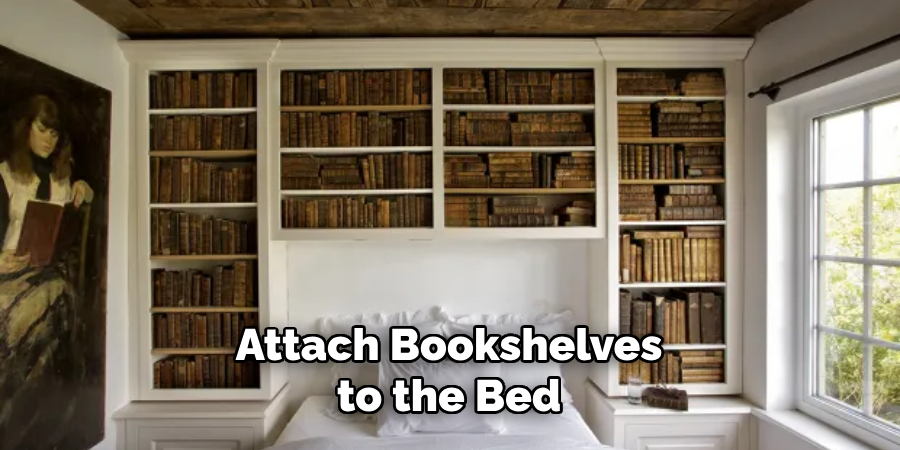
Method 7: Sanding and Finishing
After assembling the bed frame and bookshelves, sand all surfaces to smooth out any rough edges or imperfections. Start with medium-grit sandpaper and finish with fine-grit sandpaper for a smooth surface. Once sanding is complete, wipe down the wood with a damp cloth to remove dust. Apply your chosen finish—whether it’s paint, stain, or varnish—using a brush or roller. Follow the manufacturer’s instructions for drying times and apply multiple coats if necessary. Finishing your bookshelf bed enhances its appearance and protects the wood from wear and tear.
Method 8: Adding Decorative Elements
To give your bookshelf bed a personalized touch, consider adding decorative elements. You can add trim or molding to the edges of the shelves and bed frame for a more refined look. Decorative hardware, such as ornate knobs or handles, can enhance the aesthetic appeal. If you’re using paint, consider a two-tone finish or stenciling designs on the headboard or shelves. Adding these decorative elements can elevate the overall design, making your bookshelf bed a unique and stylish piece of furniture.
Method 9: Installing Lighting
Incorporating lighting into your bookshelf bed can make it even more functional and attractive. Install LED strip lights or small reading lamps along the shelves or headboard. These lights can provide ambient lighting or serve as reading lights, adding convenience and charm to your bed. Ensure the lighting is safely installed, with concealed wiring and easy access to power sources. Lighting not only adds practicality but also creates a cozy and inviting atmosphere in your bedroom.
Method 10: Assembling and Placing the Bed
Once all components are finished and dry, it’s time to assemble and place your bookshelf bed. Move the bed frame to its designated spot in your bedroom and ensure it’s level and stable. If you’ve built the bookshelves separately, attach them now, ensuring they are secure and aligned. Place the mattress on the bed frame, and arrange your books and other items on the shelves. Take a moment to admire your work and make any final adjustments. Your new bookshelf bed is now ready to use, providing both comfort and storage in a stylish package.
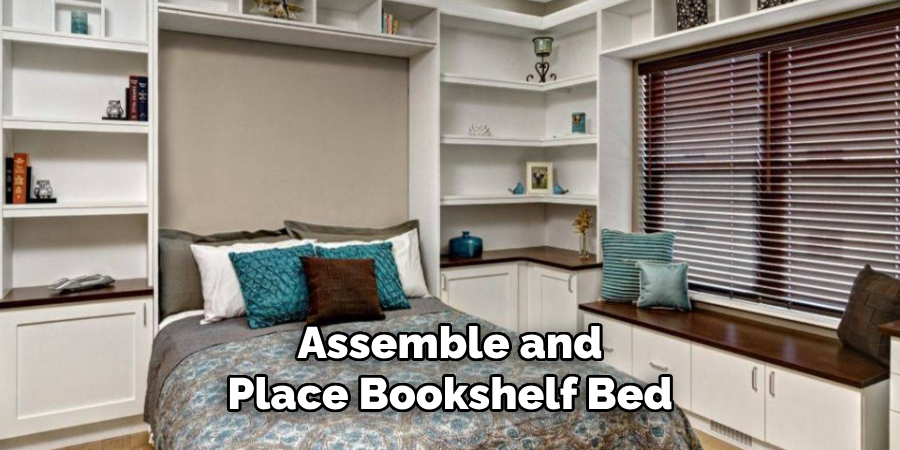
Conclusion
Creating a bookshelf bed is a rewarding DIY project that combines practicality with creativity. By following these ten elaborated methods, you can build a beautiful and functional piece of furniture that maximizes space and enhances the look of your bedroom. From designing and choosing materials to cutting, assembling, and finishing, each step requires careful attention to detail and craftsmanship.
With patience and effort, you’ll have a unique bookshelf bed that meets your needs and reflects your personal style. Enjoy the process and the satisfaction of creating a custom piece of furniture that will serve you well for years to come. Hopefully, this article gave you some helpful tips about how to make a bookshelf bed successfully, so now that you have the proper knowledge on how to get the job done, why not give it a try today?
About the Author
Adrian Green, a lifelong woodworking enthusiast, shares his passion for the craft through The Woodenify Blog. With a foundation built on years of hands-on experience in his father’s woodworking shop, Adrian is dedicated to helping others learn and grow in the world of DIY woodworking. His approach to woodworking combines creativity, practicality, and a deep appreciation for the art of building with your own hands. Through his blog, he inspires individuals of all skill levels to embark on their own woodworking journeys, creating beautiful, functional pieces of furniture and décor.
Professional Focus
- Specializes in DIY woodworking projects, from furniture to home décor.
- Provides step-by-step guides and practical tutorials for woodworkers of all skill levels.
- Dedicated to helping readers build confidence and skill through easy-to-follow instructions and tips.
- Passionate about fostering a community of makers who can share, learn, and grow together.
Education History
- University of Craft and Design – Bachelor of Fine Arts (BFA) in Woodworking and Furniture Design
- Woodworking Apprenticeships – Extensive hands-on training with skilled craftsmen to refine carpentry and furniture making techniques.
- Online Courses & Masterclasses – Continued education in advanced woodworking techniques, design principles, and specialized tools
Expertise:
- DIY woodworking, carpentry, furniture making, and home décor projects.
- Creating accessible tutorials and guides for beginner to advanced woodworkers.
- Sharing the joys and satisfaction of woodworking, from raw materials to finished products.
